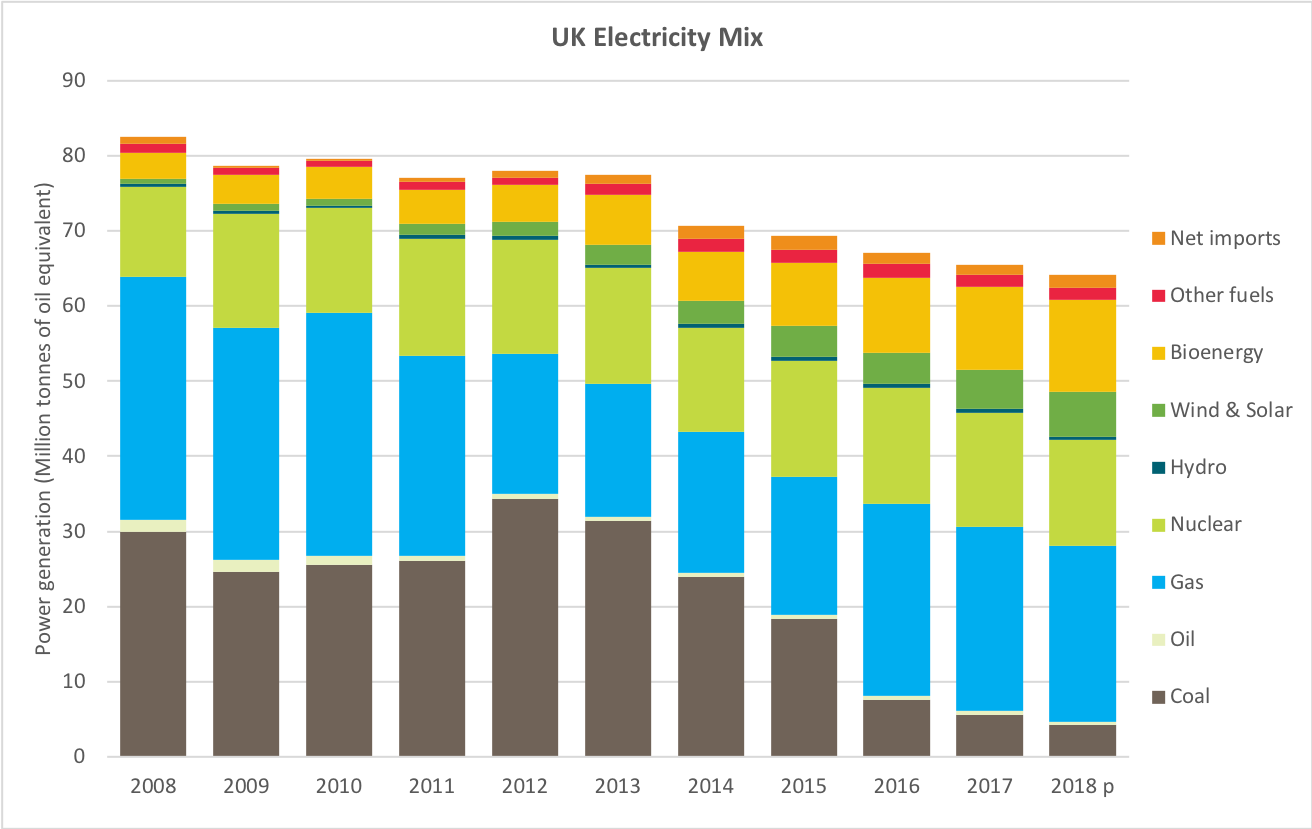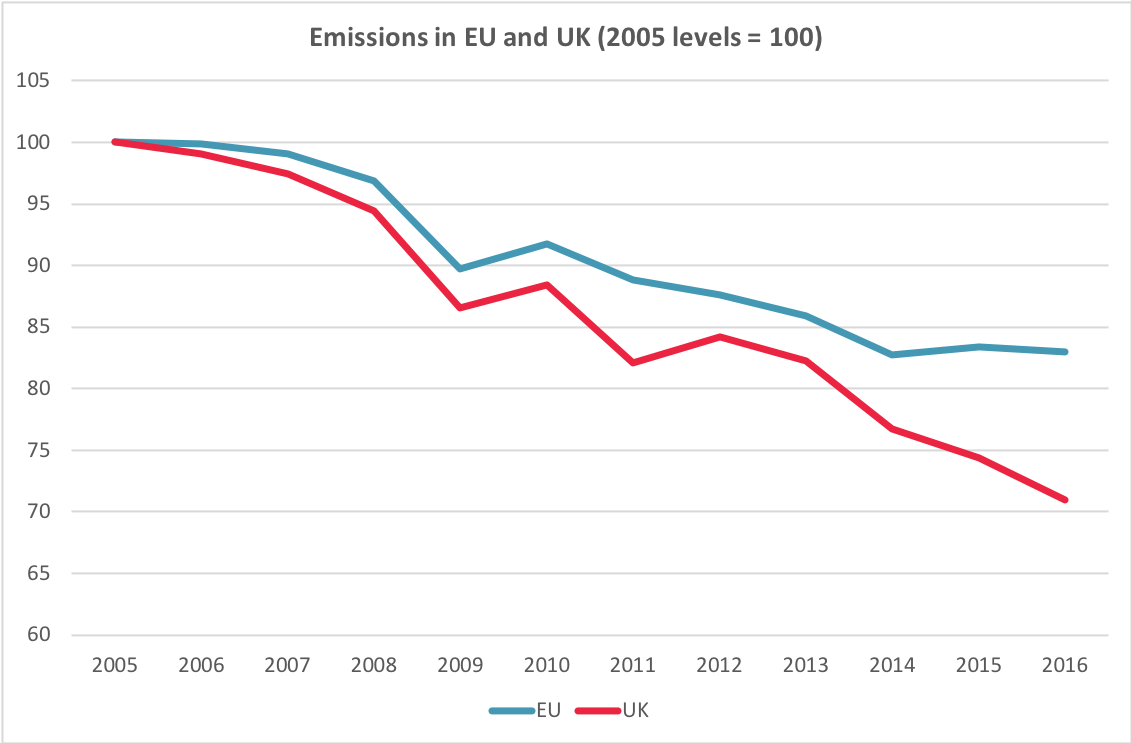
Carbon pricing works in the UK

Carbon pricing is an increasingly mainstream policy approach to slowing climate change. There are 53 carbon pricing systems operating around the world and several more in the works. Today we’ll add to our small library of case studies. The United Kingdom has used a modest carbon price to great effect and now has a roadmap to reach net-zero emissions by 2050.
A brief history
The UK was an early mover on carbon pricing. It implemented its Climate Change Levy in 2001, a patchy surcharge on electricity, gas, and petrol that applied unevenly across different firms and sectors. Early results were modest. The levy remains in place to this day.
The next stage of policy development came when the UK joined the European Union’s emissions trading system (EU ETS) in 2005. Permit prices averaged between €10 and €14 (per tonne) for the first several years of the program, but collapsed to €3 per tonne in 2013 due to permit oversupply in the European market. (Prices have since recovered.)
It was in this context that the UK introduced a domestic carbon tax in 2013: the Carbon Price Floor. The objective was to safeguard against price volatility in the EU ETS. If permit prices plummeted again, firms would still face a minimum carbon price. The Carbon Price Floor was introduced at a rate of £9 per tonne (current dollars) and doubled to £18 per tonne in 2015. It applies only to electricity producers.
A powerful incentive
The UK has shrunk its GHG emissions and maintained healthy economic growth. Since joining the EU ETS, it has reduced its emissions by 34%, while its economy has grown by 19% (which includes the Great Recession and sluggish growth post-Brexit). Over half of the UK’s emissions reductions have come from the power sector, where coal is now a bit player.
In six years of operation, the Carbon Price Floor has all but eliminated coal from the UK’s electricity mix and driven gains in energy efficiency. It has made gas-fired power more cost-effective than coal-fired power. A new paper has found that between 2013 and 2016, the Carbon Price Floor alone reduced UK emissions by 6%. Several other studies point to the carbon price as a key driver of coal’s demise.
The figure below illustrates the pronounced shift in the UK’s electricity supply over the last decade.
Source: UK Government, 2019
This shift away from coal has had a significant impact on the UK’s overall emissions. The chart below shows the decline relative to the European Union indexed against the year 2005, when the EU ETS came into force. The sharpest divergence comes after 2013, the year the Carbon Price Floor was enacted.
Source: Eurostat, 2019
In May 2019, the UK went two full weeks without deriving any electricity from coal. The federal government had initially planned to phase coal out by 2025 and appears well on its way to meeting that goal.
The removal of coal from the UK economy is driving significant health benefits. A 2013 study found coal-fired power was responsible for 1,600 premature deaths, over 360,000 lost working days, and over a million respiratory incidents every year. Totalled up, the phase-out of coal could save the UK as much as €3.6 billion in annual health costs.
A few issues
While the UK has achieved significant emissions reductions with carbon pricing, it could get even more out of its policies. Its carbon prices are still uneven across sectors. A single, more uniform carbon price that also protects the competitiveness of emissions-intensive and trade-exposed sectors would drive additional emissions reductions cost-effectively.
It is also uncertain how Brexit affects the UK’s participation in the EU ETS. It does appear that even if the UK withdraws from the EU, it would keep its own carbon prices at levels sufficient to keep coal offline.
Greater ambition
Carbon pricing has helped drive coal out of the UK’s energy mix and allowed it to cut emissions faster than nearly every other country. But the nation’s ambition extends far beyond eliminating coal from the grid. The UK’s independent climate watchdog recently laid out a roadmap to reach net-zero emissions by 2050, in line with the Intergovernmental Panel on Climate Change’s recommendations global temperature increases to 1.5 degrees Celsius.
There is broad support for legislating this new target, and carbon pricing will play an essential role in meeting it. A new report from the London School of Economics notes that a rising, credible carbon price should be “at the core” of UK decarbonization. The authors suggest a uniform carbon price starting at £40 per tonne in 2020 rising to £125 per tonne by 2050, along with other complementary measures and revenue recycling designed to increase public buy-in.
The lift will be challenging, but far from impossible. As the Committee on Climate Change noted, net-zero by 2050 is “achievable with known technologies.” What’s needed now is legislation. The UK has a lot on its plate right now, but there’s already a lot of progress to build on. It is increasingly a model for ambitious climate policy.






2 comments
Although Kevin Anderson does not specifically mention carbon pricing in his recent 5-point critical analysis of the UK Government’s “net-zero” proposal (https://kevinanderson.info/blog/brief-response-to-the-uk-governments-net-zero-proposal/ ), he does not appear to share your view that carbon pricing will play an essential role in reaching net-zero emissions by 2050.” Kevin writes:
“Whilst in many respects I welcome the headline framing of the Government’s “net-zero” proposal, sift amongst the detail and all is far from rosy. … any claim made of the UK being zero carbon by 2050, is simply not true. The scale of anticipated aviation emissions is such that this single sector will consume around one third of the UK’s Paris-compliant carbon budget, putting still further mitigation pressures on schools, hospitals and businesses to compensate for this privileged sector.”
Hi Frank,
Getting to net-zero will be challenging for any country, and aviation is a particularly tricky industry. The studies from LSE study and the Committee on Climate Change both discuss negative emissions tech as a necessary part of reaching net-zero un the UK to offset some sectors (such as aviation). The link you provided is silent on carbon pricing, so we can’t draw any conclusions about the author’s views. What we can conclude from the evidence is that carbon pricing works, and it’s the most cost-effective option for reducing emissions.
Comments are closed.